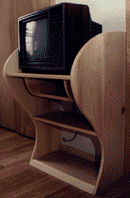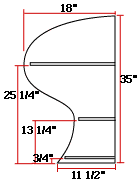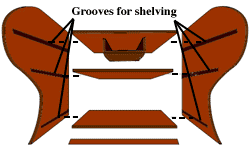Compact TV Cabinet

Although desirable, it is not always easy to add life's little comforts into a bedroom where space is a premium. By the time room has been made for the necessities of life, such as bedside cabinets, closets and a chest of drawers, there is often no room for the TV.
This was the problem that we came across when we decided to add a television to our bedroom. The only space we had was a 23 inch gap between two closets and putting a TV stand there looked ugly as it seemed to stick out too far. The solution was to design a top-heavy pine TV cabinet that gave the illusion of taking up less space than it actually does. The illusion is aided by the sweeping curves of the two sides, rather than utilizing straight lines.
Construction: The side pieces
The first stage of this project is to build the two side pieces. Each side is constructed out of two planks of pine, each 36 inches long, 9 1/4 inches wide and 3/4 inches thick. These were glued and doweled together (see the Joints section) to form one wide surface out of which the correct shape can be cut.
By referring to the plan in diagram one, sketch the shape of the side piece onto the plank of wood, and then cut this shape out, using a jigsaw. The exact shape and curve of the side piece is obviously a matter of individual taste, but it should be remembered that deviating from the above design will change the dimensions of the shelf pieces. When the first side has been cut to shape, and roughly smoothed with sandpaper, use this as a template for cutting out the second side piece. Try to ensure that these two sides are a very close match, as if they do not the cabinet will onviously look a little lop-sided.
Once both sides have been cut to shape, sand the edges to a desirable finish, ensuring that they still match each other. the best way to do this is by clamping the two together while they are being sanded down, to ensure that the curve matches correctly. Once this is done it is time to make the grooves into which the shelves will slot.

In this example, the grooves were made by using a router, cutting a half inch slot (half inch wide, 3/8 inch deep) for each of the three shelves. However, it is possible to make these slots using either a special groove planer, or by using a chisel. However, the cost of a cheap router (mine cost $25 in a garage sale) is well worth the expense as it saves a lot of time, and produces an accurate finish.
To ensure the grooves are straight, clamp a metal ruler onto the side piece that can act as a guide for the router base. Once the three grooves are cut, repeat this process on the second side piece, ensuring that you cut on the correct, inside face (i.e. the opposite face to the first side piece).
Once these grooves are cut, the two side pieces are complete.
The shelves
The shelves are made out of half inch plywood, but a pine edging piece is added to the front of each shelf to give a better feeling of depth to the shelves. The exception - or rather, the variation - to this rule, as we shall see lower down, is the bottom shelf.
The dimensions of the shelves used in this plan are as follows:
- Top shelf: 22 3/8 wide, 17 1/2 inch deep
- Middle shelf: 22 3/8 wide, 9 3/4 inch deep
- Bottom shelf: 22 3/8 wide, 10 inch deep
Cut these dimensions out of 1/2 inch thick plywood, and sand using medium and fine sandpaper. Once this is done, you must then create the pine edging as follows.
Cut two lengths of pine, each 21 5/8 long and 3/4 wide and deep. Cut a groove into each of these along one side of the length that is 1/2 inch wide and 3/8 inch deep using the router. Check that this groove will allow the 1/2 inch thick plywood to slot into it. However, do not glue the edging piece onto the plywood yet.
The construction of the bottom edging piece is slightly more arduous as this is a larger piece of wood. Construct a piece of pine that is 21 5/8 inches long, 1 1/2 inches wide and 1 1/2 inches deep. The easiest way to make this thickness is to glue two 3/4 inch thick pieces of pine together.

Once this base piece has been constructed, cut a groove 1/2 inch wide, and 3/8 inch deep along the back of it, 1/4 inch from the top of the wood. Note: the back and the front should be the solid side of the pine construction, with only the top and bottom showing any sign of the joint between the two 3/4 inch thick pieces.
This solid piece of wood must now be planed down to the same angle as the lowest 1 1/2 inches of the side pieces (please refer to the diagram for a rough example of the side profile of this piece).

Once this is complete, it is time to put all of the elements together. Place wood glue in the three slots on each side piece, and slide the three shelves into these slots. Make sure that you do not confuse the bottom and middle shelves as they are very similar depths. Clamp this together and leave to dry for several hours, ensuring that the sides are perpendicular to the shelves.
When dry, you can glue the edging strips and the base strip onto the front of the shelves, clamping in place again until dry.
At this point, you have the shell of the final TV cabinet in front of you, and very little is needed to finish it off. Firstly, screw a piece of pine, 22 5/8 inches long, 2 inches wide and 3/4 inches thick to the bottom of the top shelf, at the back. This piece of pine is used to fix the TV cabinet into the wall (using screws) when the project is complete. The surface being screwed into the top shelf should be 3/4 inch wide.
If there is no need for a Cable box shelf, please skip the next section of this project.
Cable Box Shelf
The construction of the cable box shelf is like a cut down version of the above project. The shelf hangs from the top shelf, rather than being the full width of the unit. Cut two pieces of pine, 14 1/2 inches long, 5 1/2 inches wide and 3/4 thick to make the sides of the shelf. One end of each of these pieces should be shaped into a curve in order to match the general curve of the cabinet under the top shelf.
Cut a groove into each of these side pieces - again, 1/2 inch wide and 3/8 inch deep - for the shelf to slot into. This slot should be 1/2 inch from the lower edge of each side piece. Cut a shelf out of the 1/2 inch plywood that is 13 inches wide, and 10 1/4 inches deep. Again, make a front edging piece for this shelf out of pine, as described above, and then glue the pieces together.
To attach the cable box shelf to the rest of the unit, glue and screw the unit to the underside of the top shelf, ensuring that the cable shelf is central. Do not worry about the fact that the screws show on the top shelf as these will be covered by the television.
Finishing Off
To finish off the project, sand the entire unit down ensuring that all the sharp edges are neatly rounded off. Then wax the unit, as explained in the Finishes Department.